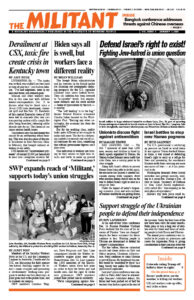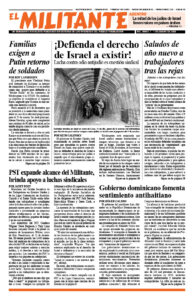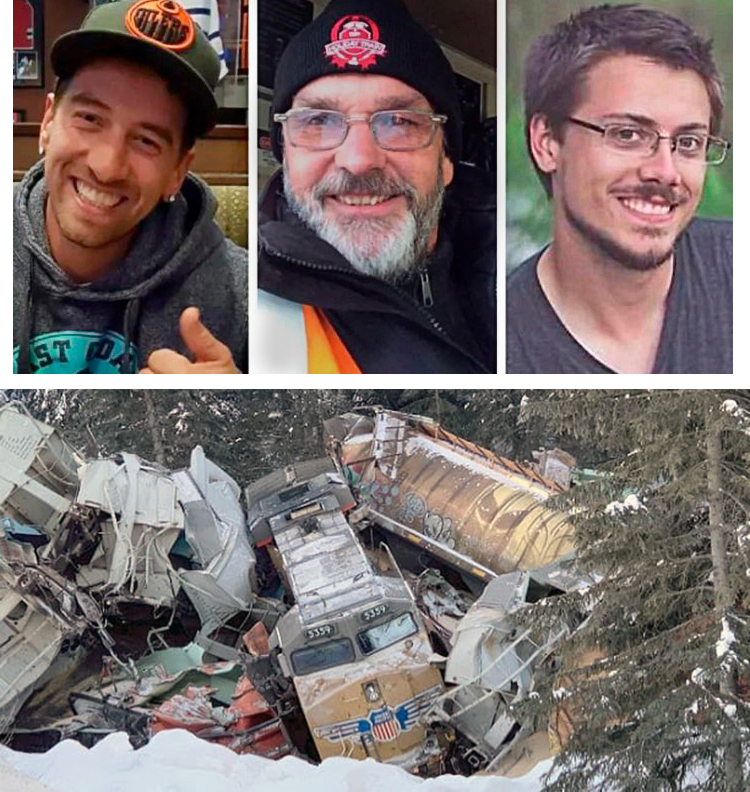MONTREAL — After a series of deadly accidents, the U.S. Federal Railroad Administration issued a recent “advisory” urging rail bosses to expand use of technology to deal with the increased danger of operating in adverse weather conditions. According to the federal railroad agency, there have been 123 rail “incidents” in which severe weather or weather-related conditions may have contributed in part or in whole to an accident since 2021. More than half were main-track derailments.
But railroad workers in North America and their unions know it is the profit drive of the rail bosses that endangers them and other workers who live and work near the tracks, not the weather.
One of the most treacherous stretches of railroad in North America is a mountain slope near Field, British Columbia. It falls 2.2 feet for every 100 feet of track in a little over 3 miles, with several sharp curves.
Canadian Pacific engineer Andrew Dockrell, conductor Dylan Paradis and trainee Daniel Waldenberger-Bulmer were killed Feb. 4, 2019, when their train rolled on this stretch of track without adequate air brakes. The train had been pulling 112 loaded grain hoppers, weighing over 15,000 tons. It was over 5,500 feet long. All but 13 cars derailed.
Prior to the derailment, a brake failure had forced an earlier crew to park the train and engage the emergency air brakes. The train remained immobilized for two and a half hours until the relief crew of Dockrell, Paradis and Waldenberger-Bulmer arrived, while the weakened air brake system was losing air.
The new crew was told by their supervisor to get going as soon as possible. The engineer thought it would be safer if the conductor and trainee applied a number of hand brakes to keep the train still while the air brakes recovered. Before they could even get started, the train started rolling. They tried to stop it but it was impossible.
This slope has been the site of numerous runaway trains and derailments over the last century, including one just a month before. A 159-car Canadian Pacific Railway train suffered an emergency air brake release, bringing it to a sharp halt and causing 15 cars to derail.
The families of two of the three men killed in the February derailment filed a lawsuit in April 2021 charging negligence against Canadian Pacific, its CEO, board of directors, CP police and the federal minister of transport. They charge the company with cutting corners to increase profits at the expense of employees’ safety.
Canadian Pacific had a history, the lawsuit says, of keeping in service “bad ordered” cars that had malfunctioning brakes and other mechanical defects. As for the train in this disaster, “where these cars had any brakes at all, they were worn beyond their capacity for safe and effective application,” the suit says. The case is still working its way through the courts.
In another death related to adverse weather conditions, Jarrod Ward, a 34-year-old Canadian National conductor, was killed March 16, 2014, when an autorack railcar he was riding on derailed on an icy grade-crossing. Coroner Michel Ferland wrote in his report the tracks where Ward was working hadn’t been cleaned since the start of winter. Many workers, including Ward himself, had urged management to get the ice cleaned off the tracks.
“This death could have been avoided with better maintenance of the environment, or simply by not moving cars under these conditions,” Ferland found.
Ward’s two sisters sued the company for $1 million, charging negligence. “The defense neglected to follow simple measures of rail maintenance and, as a consequence, a 34-year-old father lost his life,” the family’s lawyer, Laura-Ann Weir, said.
Railroad workers need to organize to use union power to fight for workers’ control over working conditions and safety. Rail conductors on the Canadian National set an example with their “strike for safety” in 2019.
Today this includes fighting for trains no longer than 50 cars, proper maintenance and for bigger train crews. Each one of the above-cited incidents could have been avoided by one or more of these measures.
Joe Swanson, a retired rail worker in Lincoln, Nebraska, contributed to this article.


